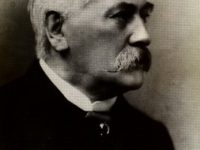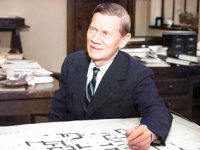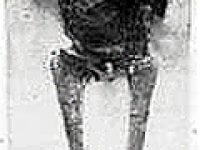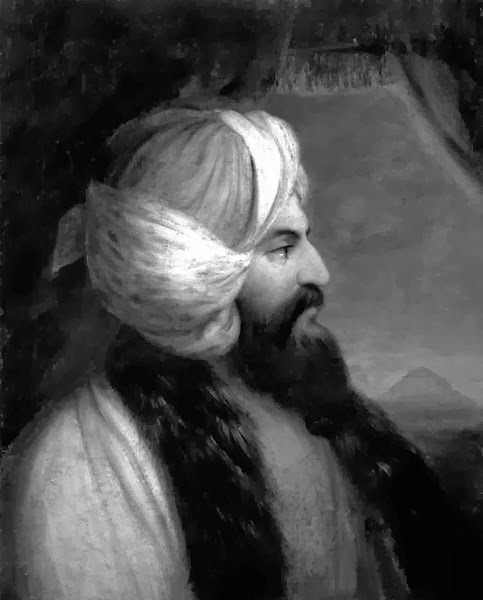
Giovanni Battista Belzoni (1778-1832)
On March 2, 1818, Prolific Italian explorer Giovanni Battista Belzoni – also known as ‘The Great Belzoni‘ – discovered the burial chamber of Pharaoh Khafra in the 2nd of the large pyramid‘s of Giza. But, like in all the other burial chambers in the great pyramids, the sarcophagus was empty.
Early Years
Belzoni was born in Padua, Italy, as the son of a barber. At the age of 16, he moved to Rome in order to work there, but after the French troops occupied the city in 1798, he moved to the Netherlands where he became a barber himself as well. However, only three years later, the Italian had to continue his journey to England in order to avoid being send to jail. He met a young woman called Sarah Bane and together, they joined a traveling circus. They performed exhibitions at fairs as well as on the streets of London and even joined several shows at Astley’s amphitheatre.
Travelling with the Circus
Along with his circus, Belzoni left England in 1812. They toured across Europe, performing in Spain, Portugal, and Sicily. In the following period, he went to Malta, where he met Ismael Gibraltar, an emissary of Muhammad Ali. Belzoni, who increased his interest in hydraulics during his time in Rome, wanted to show Ali a hydraulic machine that he invented by himself for raising the waters of the Nile River. His demonstration went by smooth, but still the project was not approved.
The Young Memnon
Belzoni was now without a job, but willing to continue his travels. He was supported by the famous orientalist Johann Ludwig Burckhardt [4] to travel to Egypt. He got the permission by Henry Salt, Egypt’s British consul to travel to the Ramesseum at Thebes, from where he removed with great skill the colossal bust of Ramesses II,[11] commonly called “the Young Memnon“. The piece weighs more than 7 tons and it took 130 men to tow it to the river in over two weeks. The Young Memnon is on this day still a very prominent display at the British Museum.
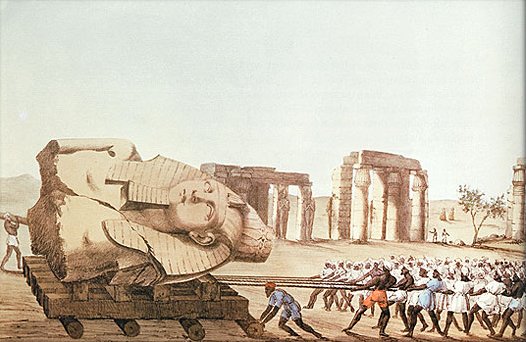
Transport of the bust of Ramses II.
It was this colossal head and his finding situation that inspired Percy Bysshe Shelley to write his famous poem Ozymandias.[10] At that time there was a fierce competition between robbers in Egypt, especially between Henry Salt and his greatest rival, the French consul Bernardino Drovetti, the Turkish-Egyptian authorities, and the Fellahs. On the one hand, the French wanted valuable antiques for the Louvre and the English for the British Museum, and on the other hand, bribes for government officials and the highest possible profits for the Fellahs. In addition, countless smaller traders and collectors searched for grave treasures, and local groups of robbers also cooperated with them. Despite numerous intrigues on Drovetti’s part, Belzoni succeeded in carrying out the order successfully in 1816.
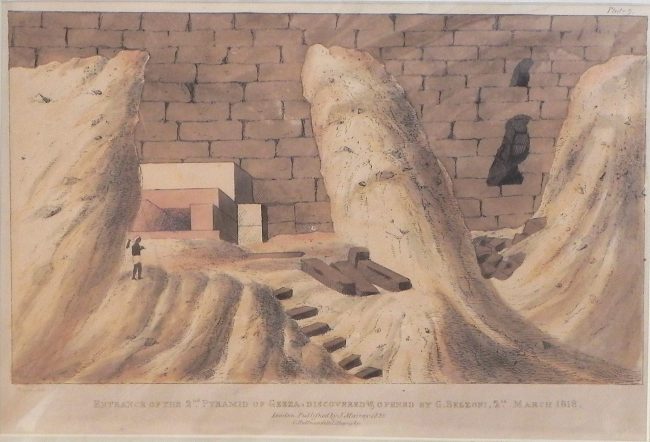
Entrance of the 2nd Pyramid of Geeza, Discovered and Opened by G. Belzoni, 2nd March 1818, Musée d’Art classique de Mougins
Edfu and Elephantine
During his travels, Belzoni also managed to expand his investigations to the great temple of Edfu. It is one of the best preserved temples in Egypt and is dedicated to the falcon god Horus. The inscription on the walls gave a great impression on the languages, myths and religion during the Greco-Roman period. Furthermore, Belzony managed to visit Elephantine, an island in the Nile River with several important archeological sites and Philae, an island in Lake Nasser. In 1817 Belzoni returned to Thebes and discovered the graves KV17 (Sethos I.), KV16 (Ramses I.), WV23 (Eje), KV19 (Montuherchepschef, son of Ramses IX.), KV21, WV25, KV30 and KV31 in the Valley of the Kings. In 1818 Belzoni discovered the entrance to the pyramid of the Chephren in Gizeh and reached the burial chamber. Belzoni was also the first European to visit the Siwa oasis, and he found the ruins of Berenike on the Red Sea.
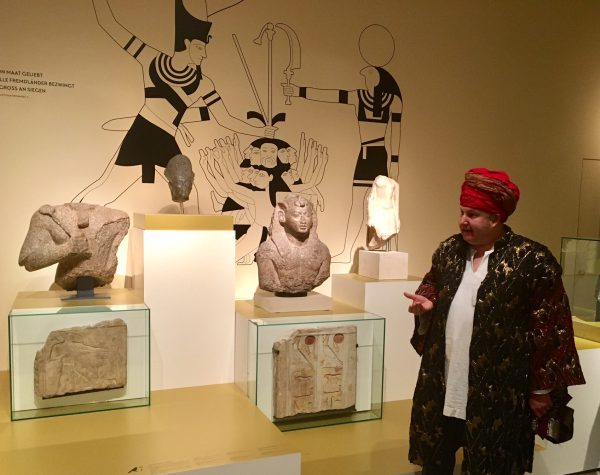
‘The Great Belzoni’ himself was acting as a tour guide on the Ramesses II exhibition at the Badisches Landesmuseum, Karlsruhe [11]
The Burial Chamber of Khafra
In 1818, Belzoni was the first known to penetrate into the second pyramid of Giza, where he discovered the famous burial chamber of Khafra. In the summer of 1818 Belzoni and Alessandro Ricci wrote a documentary about KV17 (Belzoni’s tomb). He left Thebes on 27 January 1819 and returned to England in March 1820. He presented his discoveries in Egypt in the exhibition at Egyptian Hall on 1 May 1821 at Piccadilly in London. Due to the great interest, the exhibition remained open for almost a whole year.
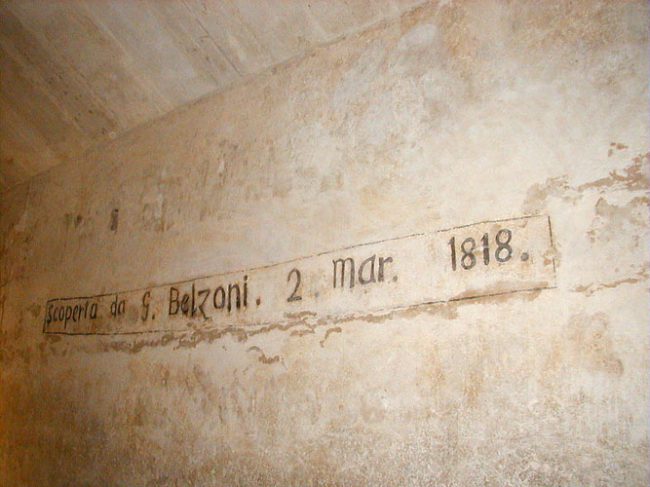
Inscription of Belzoni inside the Pyramid of Khafre
The Last Travel
One year later, the Great Belzoni returned to England in order to publish writings about his many travels and adventures titled “Narrative of the Operations and Recent Discoveries within the Pyramids, Temples, Tombs and Excavations in Egypt and Nubia, &c”. However, in 1823, Belzoni set out for West Africa willing to visit Timbuktu, but due to problems at the border of Morocco, he chose the Guinea route. After reaching the Kingdom of Benin, Giovanni Battista Belzoni passed away on December 3, 1823, at age 45, due to on this day unknown reasons. In 1862, Richard Francis Burton searched for his grave. Only one tree grew at the place where Giovanni Battista Belzoni was buried.[5]
HI121: The original tomb raiders – a short history of early Egyptology, [11]
References and Further Reading
- [1] Belzoni at the Ancient Egypt Website
- [2] Belzoni at Open Library
- [3] Belzoni at Britannica Online
- [4] Johann Ludwig Burckhardt and the discovery of Petra, SciHi Blog
- [5] The Adventures of Sir Richard Francis Burton , SciHi Blog
- [6] Giovanni Battista Belzoni at Wikidata
- [7] Chisholm, Hugh, ed. (1911). . Encyclopædia Britannica. 3 (11th ed.). Cambridge University Press.
- [8] Works by Giovanni Battista Belzoni at LibriVox
- [9] Ramesses II – King of Kings am I, SciHi Blog
- [10] Gothic – The Life and Works of Percy Bysshe Shelley, SciHi Blog
- [11] HI121: The original tomb raiders – a short history of early Egyptology, Wilfrid Laurier University, Alicia McKenzie @ youtube
- [12] Timeline of Explorers of Africa, via DBpedia and Wikipedia


